 Victoria Lomasko is probably most famous in the West for her drawings from the frontlines of the Pussy Riot trial. Starting with fraudulent Duma elections on December 4, 2011, and until November 2012, she kept a graphic “chronicle of resistance” in which she made on-the-spot sketches of important protest-related events. For several years now she has been working as illustrator and her work is published in several magazines and newspapers.
Victoria Lomasko is probably most famous in the West for her drawings from the frontlines of the Pussy Riot trial. Starting with fraudulent Duma elections on December 4, 2011, and until November 2012, she kept a graphic “chronicle of resistance” in which she made on-the-spot sketches of important protest-related events. For several years now she has been working as illustrator and her work is published in several magazines and newspapers.
Viktoria Lomasko

Monstrations
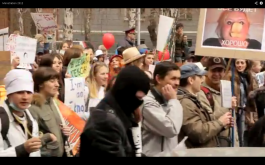
(Artyom Loskutov and Maria Kiselyova, organisers)are rallies whose participants shout and carry absurdist slogans, like “Wear a mustache!”. Starting in their native Novosibirsk, Monstrations have become a popular ‘genre’, combining the habitus of political activism with legally harmless slogans, confusing the authorities.
///////////////////////
Artyom Loskutov and Maria Kiselyova are mostly famous for organizing Monstrations – annual rallies whose participants carry absurdist banners like “Tanya, don’t cry!” or “Somehow like this” in their home town of Novosibirsk. These “happenings” are emblematic of a new trend in Russian post-Soviet art: combining political statements with artistic sensibilities, and often blurring the line between the two. In 2009 inspired by Monstrations agents of the Anti-extremism center planted 11 grams of marijuana on Loskutov, starting his rich criminal history. In March 2012 Kiseleva and Loskutov put images of a woman in balaklava with a baby on her lap, made by Kiseleva and based on the famous orthodox icon, into several street billboards. The “icon” came complete with a stylized inscription in support of the Pussy Riot group. The artist was fined for his action, the court considered the image to be insulting religious feelings of “all orthodox and catholic christians”.
Anatoly Osmolovsky
 has been a figure of reference in the Russian art world since the early 1990s, co-founding and leading several groupings, including Radek Magazine (1995), which sought a space for intellectual resistance and anarchist tactics. Currently, he runs the BAZA Institute.
has been a figure of reference in the Russian art world since the early 1990s, co-founding and leading several groupings, including Radek Magazine (1995), which sought a space for intellectual resistance and anarchist tactics. Currently, he runs the BAZA Institute.
///////////////////////////
Anatoly Osmolovsky began his career as a writer, and was a member of the literary group “Vertep” before 1989. Between 1990-92, he was the leader of the ETI (Art Territory Expropriation) movement, and participated in a series of street performances/provocations, including “Fuck,” “We feel colds,” “Index Finger,” and “Perusing with Fire.”In 1995, Osmolovsky founded Radek magazine, which sought to create a space for radical politics under a current atmosphere of official suppression, and to develop paths for intellectual resistance and anarchist tactics for decision-making. The distribution of Radek began as a mail-art project due to lack of sponsoring. In 1997, Oleg Kireev joined Mailradek, which was thereafter continued in the form of electronic mail distribution, expanding its scope by making open invitations for contributions by other authors.
MediaImpact

 is a platform of activist art which has, since 2011, organised the first festivals of their kind in Russia. Coordinated by Tatiana Volkova of Zhir Gallery, it has developed exhibitions, international cooperation, and the discourse and practice of activist art in cities across Russia.
is a platform of activist art which has, since 2011, organised the first festivals of their kind in Russia. Coordinated by Tatiana Volkova of Zhir Gallery, it has developed exhibitions, international cooperation, and the discourse and practice of activist art in cities across Russia.
////////////////
The MediaImpact International Festival of Activist Art engages in research, articulation, promotion and development of art-activism – of art that aims to effect social change. The MediaImpact is the first festival of its kind in Russia that addresses and works with the phenomenon of activist art on different levels: that of discourse, exhibition, practice and collaboration. The geographical scope of this project is very broad, involving a wide network media-activists from different regions of Russia proper and of the post-Soviet space – Moscow, Saint-Petersburg, Krasnodar, Novosibirsk, Murmansk, Yekaterinburg, Yerevan, Minsk and Kiev, not to mention Europe and North America.
MediaImpact was initiated by ZHIR Project in autumn 2011 in Moscow. Exhibitions, lectures and workshops have taken place at ARTPLAY Center supported by the Partisan Museum; artistic interventions have spilled out into the streets and public spaces. Art that steps out into the public space in order to call for social change is a relatively recent phenomenon in Russia. Artists forge new forms of collective existence by joining forces with subcultures and social movements and by claiming an activist identity—an identity marked by active participation in today’s social and political reality. The development of this genre has evolved alongside the emergence of civil society in Russia, which has been accompanied by a rise of mass protests on the one hand and political repression on the other. In this case artists become precursors to and catalysts of social processes, but they also assume a heroic role as they go out into the street to confront the system.
The project encompasses a variety of forms and communication strategies of art activism such as community-based art, ecology and cultural heritage, politics, tactical media, music of protest and environmental art. The festival program consists of art-residencies, workshops and presentations, discussions and debates, as well as exhibitions and public art actions.
Marina Naprushkina
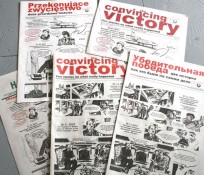
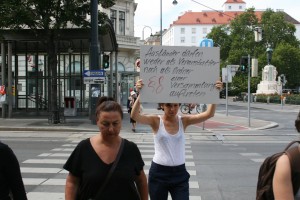 is a Belarusian artist and activist in opposition to the regime of Alexander Lukaschenko. Her Office for Anti-Propaganda (founded 2007), continuously invents new strategies and tactics for countering the oppression of freedom of thought and action in Belarus today.
is a Belarusian artist and activist in opposition to the regime of Alexander Lukaschenko. Her Office for Anti-Propaganda (founded 2007), continuously invents new strategies and tactics for countering the oppression of freedom of thought and action in Belarus today.
////////////////////////////////
Marina Naprushkina’s work concentrates on power structures in nation-states, often making use of nonfiction material such as propaganda issued by governmental institutions in Belarus. Since 2007 she runs the Office for Anti-Propaganda, which participates in and organizes political actions and also publishes newspapers. The focus is on Belarus „The Office for Anti-Propaganda” is the result of long-standing work in gathering and archiving the original propaganda material and the works of the artists. The works demonstrate how state authority affects society, and transforms democracy into an illusion for those living under the persistent hegemony of the ruling network.
Kirill Medvedev
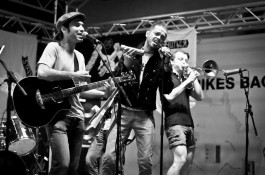
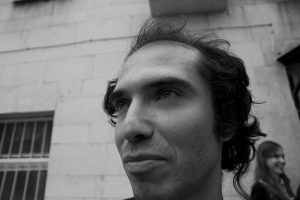 is an internationally renowned Russian poet, translator and socialist from Moscow. An English anthology, “It’s No Good” was published by Ugly Duckling Presse in 2012. Medvedev is the founder of the Free Marxist Press and the riot-punk-folk band Arkady Kots.
is an internationally renowned Russian poet, translator and socialist from Moscow. An English anthology, “It’s No Good” was published by Ugly Duckling Presse in 2012. Medvedev is the founder of the Free Marxist Press and the riot-punk-folk band Arkady Kots.
///////////////////////
Kirill Medvedev is a revolutionary Russian poet, translator and hard-core socialist from Moscow. His extensive poetry anthology It’s No Good was published by Ugly Duckling (New York) last year. It’s No Good includes selected poems from Medvedev’s four books of poetry as well as his most significant essays: “My Fascism” (on the failure of post-Soviet Russian liberalism, politically and culturally); “Literature and Sincerity” (on the attractions and dangers of the “new sincerity” in Russian letters); “Dmitry Kuzmin, a Memoir” (a detailed memoir and analysis of the work of the 1990s Moscow poet, publisher, and impresario Kuzmin, and what his activity represents).
Kirill is also a founding member of riot-punk-folk band Arkady Kots. Arkady was also a Russian revolutionary poet and translator, for instance this was Arkadiy Kots himself who translated L’Internacionale into Russian, this first version lately became national anthem for early Soviet state. By the time band Arkady Kots gave their first gig as a band, in year 2009, there were just two of them on stage Kirill Medvedev – singing and playing acoustic guitar, and Oleg Jouravlev – young Russian sociologist on keyboards made all the arrangements. Now there are nine musicans on the stage.
Ivan Brazhkin
participated in various actions of the Radek сommunity (Moscow) in 2002-04, and today works in a variety of genres – from video and installation to graphics and sculpture.
/////////////////////////////////
Ivan Brazhkin (1985 -, Rostov-on-Don, Russia) is an artist and political activist who lives and works in Moscow. He started as an experimental poet and musician. He has been participating in exhibition projects in Russia and abroad since 2002. In the period 2002 – 2004 he participated in various actions of the Radek сommunity (Moscow). He cooperates with various leftist political organizations. Brazikin works with different media, from video and installation to graphics and sculpture.
Leonid «Arch Genius»
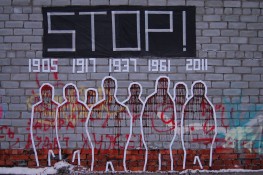
is a street-artist and activist who organises DIY-events in Murmansk. He is an active participant in several civil and human rights initiatives, and the editor of the Youth Human Rights Newspaper.
///////////////////////////////////////////
Friends call Leonid Arch, but the full name of the creative pseudonym – Arch Genius, that reflecting his commitment to the progressive versatile development, personal growth and self-realization. He works as a chief editor of the “Youth Human Rights Newspaper”, that published in Murmansk: http://yhrp.blogspot.ru/
He started his art way from break-dance. In parallel, he studied independently drawing and doll-making. In 2011 he started working in the field of street art and art activism. In April 2012, he became the winner of “Narcophobia. Open Call”, held in Zverev Center of Contemporary Art, won a trip to Germany for the Berlin Biennale of Contemporary Art. In his town, Leonid tries to develop contemporary art and organises DIY-events. He is an active participant in the civil and human rights initiatives.
ZIP Group
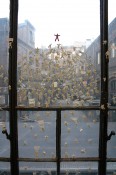
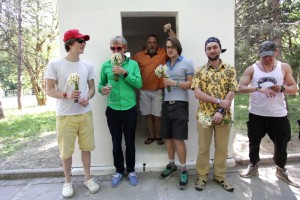 Works:
Works:
Three Chairs for RE-ALIGNED ART
Flag Washing Machine (Carousel) for RE-ALIGNED ART
The Construction for TO THE SQUARE 2
Free Construction at Frolivska 9/11 IDP Camp and at the VCRC, as part of The School of the Displaced curated by Perpetuum Mobile at The School of Kyiv, the 2nd Kyiv Biennial.
The ZIP Group’s critical and at time hilarious works stimulate and engage, while creating self-organized community spaces, such as in their native Krasnodar. The art-group ZIP was founded in 2009 in Krasnodar, in the south of Russia. The group consists of four young artists – Eldar Ganeev, Evgeny Rimkevich, and the brothers Stepan and Vasily Subbotin. The ZIP is based at former Soviet factory (ZIP means Factory of Measuring Devices) and thus keeps connection with the Soviet past. The ZIP Group explores industrial artifacts of our history and makes co-projects with workers. In the project “Utopia” the factory becomes a kind of independent state – the “island” of freedom for artists and creative people. In Krasnodar as well as in entire Russia there isn’t any system of art institutions which would support young artists. So, using the spaces of ZIP, they have founded own self-declared Institute of Contemporary Art — KICA.
Roman Minin
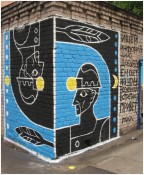
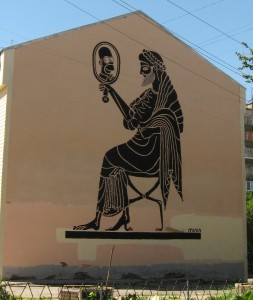 is best known for his iconic work “Homer” (Perm) and “SnowDen” (Re-Public/Re-Aligned, Helsinki). He works in many genres, from graphic works lamenting the disappearance of his native Donetsk mining culture to street art and oils.
is best known for his iconic work “Homer” (Perm) and “SnowDen” (Re-Public/Re-Aligned, Helsinki). He works in many genres, from graphic works lamenting the disappearance of his native Donetsk mining culture to street art and oils.
///////////////////////
Roman Minin (b. 1981) from Kharkov, Ukraine, is a participant of many group exhibitions and festivals, the organizer of “Street Art Fest” in Kharkov. He was for example the head of the program “ISOLIATSYA in city space” in the center of the modern art ISOLIATSYA in Donetsk 2012.
























































